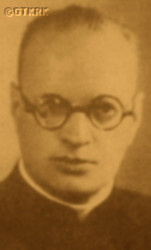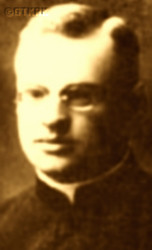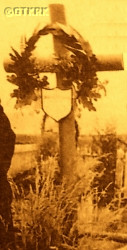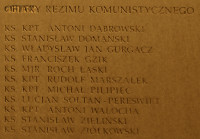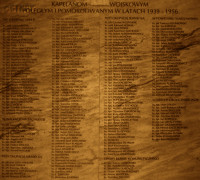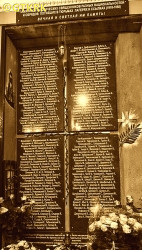Roman Catholic
St Sigismund parish
05-507 Słomczyn
85 Wiślana Str.
Konstancin deanery
Warsaw archdiocese, Poland
full list:
displayClick to display full list

searchClick to search full list by categories
wyświetlKliknij by wyświetlić pełną listę po polsku

szukajKliknij by przeszukać listę wg kategorii po polsku

Martyrology of the clergy — Poland
XX century (1914 – 1989)
personal data
surname
PEREŚWIET-SOŁTAN
forename(s)
Lucian (pl. Lucjan)
function
diocesan priest
creed
Latin (Roman Catholic) Church RCmore on
en.wikipedia.org
[access: 2014.09.21]
diocese / province
Vilnius archdiocesemore on
en.wikipedia.org
[access: 2013.05.19]
RC Military Ordinariate of Polandmore on
en.wikipedia.org
[access: 2014.12.20]
date and place
of death
21.01.1951

ITL MinLagGuLAG slave labour camp network
today: Inta, Komi rep., Russia
more on
en.wikipedia.org
[access: 2022.01.09]
alt. dates and places
of death
23.01.1951
details of death
On 01.01.1939 named a chaplain of the reserves of the Polish Army and in 08.1939 mobilised as the chaplain of 5th Joseph Piłsudski Legions Infantry Regiment within 1st Legions Infantry Division.
After German and Russian invasion of Poland in 09.1939 and start of the World War II, prob. took part in defense on Bug river line and then prob. in Lublin region.
After the Polish defeat, returned to his parish, perhaps then under Russian occupation, or perhaps already under Lithuanian rule – on 27.10.1939, Lithuania "took over", under the "Treaty of Mutual Assistance and the Transfer of Vilnius and the Vilnius Region to Lithuania", signed on 10.10.1939 and ratified on 14.10.1939, part of Poland from the hands of the Russian occupier, thus becoming one of the four countries that carried out the Fourth Partition of Poland in 1939 (the others were Germany, Russia and Slovakia).
In the spring of 1940 interned by Lithuanians in Liškiava and then deported to the eastern regions of Lithuania.
After annexation of Lithuania by Russians on 15.06.1940 and start of Russian occupation returned to his parish again.
Catechist in clandestine gymnasium and lyceum.
After German attack on 22.06.1941 of their erstwhile ally, Russians, and start of German occupation, chaplain to Boleslav Chrobry 1st Panzer Regiment (in battalion strength) of Polish resistance Home Army AK (part of Polish Clandestine State) in Vilnius and then from 02.1942 chaplain of C Quarters of AK Garrison Vilnius–City under "Reaper" nom–de–guerre.
Took part in efforts to provide shelter to the Jews.
Arrested on 17.09.1943 by Lithuanians and Germans as reprisal for Home Army AK activities and jailed in ZAL Prawienischkien slave labour camp.
Ransomed out.
Nominated chaplain to Home Army AK Vilnius region health service.
During Operation "Ostra Brama" (Eng. "Gate of Dawn") of 07–15.07.1944 – the capture of Vilnius by AK units, cooperating with the advancing Russian troops carrying out a major offensive known as "Operation Bagration" – ministered as a chaplain among the AK soldiers. After the liberation of Vilnius, avoided arrest by the Russians, who treacherously arrested the AK command staff and interned AK soldiers, transporting most of them to the Gulag slave labor camps.
On 31.12.1944 arrested by Russians accused of collaboration with Home Army AK.
Jailed in Vilnius prisons – in Lukišk?s, among others.
Tortured.
On 04.08.1945 deported to Russian slave labour concentration camp ITL VorkutLag, part of Gulag complex.
From 15.08.1945 slaved in coal mine No. 8 ("Rudnik").
On 30.07.1946 released.
Settled in Povalnoye village.
Arrested again on 20.01.1949 by Russians.
Accused of "maintaining criminal relationship with w members of Polish, nationalist AK organisation […] and setting up and running a hospital for them, collecting funds and food, and organising shelter and help in hiding […], receiving and distributing anti–Russian leaflets. In 1947 had a contact with escapees from NKVD concentration camps and helped them to escape abroad. Maintained correspondence with persons sentenced for anti–Russian activities, including members of their families in Poland".
On 21.11.1949 sentenced by Russians, prob. pursuant to Art. 58–1a of the Russian criminal code, to 25 years of slave labour in Russian concentration camps – Gulag.
Slaved in the ITL MinLag coal mines – prob. in Inta city – in Komi republic.
There in mid 01.1951 when saying a Mass attacked and beaten up, got a paralysis of the right side of the body and the same day perished.
cause of death
extermination: murder / exhaustion
perpetrators
Russians
sites and events
ITL MinLagClick to display the description, ITL VorkutLagClick to display the description, GulagClick to display the description, Vilnius (Lukiškės)Click to display the description, Help to the JewsClick to display the description, ZAL PrawienischkienClick to display the description, LiškiavaClick to display the description, Ribbentrop‐MolotovClick to display the description, Pius XI's encyclicalsClick to display the description
date and place
of birth
05.05.1906

Pyerasvyatoyetoday: Pyerasvyatoye ssov., Rechytsa dist., Gomel reg., Belarus
more on
be.wikipedia.org
[access: 2023.01.18]
parents
PEREŚWIET-SOŁTAN John Romualdo
🞲 ?, ? — 🕆 ?, ?

RODZIEWICZ Caroline
🞲 ?, ? — 🕆 ?, ?
presbyter (holy orders)
ordination
04.06.1933

Vilniustoday: Vilnius city dist., Vilnius Cou., Lithuania
more on
en.wikipedia.org
[access: 2022.01.06]
St John the Baptist and St John the Evangelist RC churchmore on
en.wikipedia.org
[access: 2017.05.20]
positions held
1939 – 1949
parish priest — Vileyka Colonytoday: part of Naujoji Vilnia district in Vilnius, Vilnius city dist., Vilnius Cou., Lithuania
more on
en.wikipedia.org
[access: 2021.12.18] ⋄ Christ the King and St Therese of the Child Jesus RC parish ⋄ Vilniustoday: Vilnius city dist., Vilnius Cou., Lithuania
more on
en.wikipedia.org
[access: 2022.01.06] RC deanery
1937 – 1939
curatus/rector/expositus — Vileyka Colonytoday: part of Naujoji Vilnia district in Vilnius, Vilnius city dist., Vilnius Cou., Lithuania
more on
en.wikipedia.org
[access: 2021.12.18] ⋄ Christ the King and St Therese of the Child Jesus RC church ⋄ Vilniustoday: Vilnius city dist., Vilnius Cou., Lithuania
more on
en.wikipedia.org
[access: 2022.01.06], St John the Baptist and St John the Evangelist RC parish ⋄ Vilniustoday: Vilnius city dist., Vilnius Cou., Lithuania
more on
en.wikipedia.org
[access: 2022.01.06] RC deanery
1933 – 1937
vicar — Vilniustoday: Vilnius city dist., Vilnius Cou., Lithuania
more on
en.wikipedia.org
[access: 2022.01.06] ⋄ St John the Baptist and St John the Evangelist RC parish ⋄ Vilniustoday: Vilnius city dist., Vilnius Cou., Lithuania
more on
en.wikipedia.org
[access: 2022.01.06] RC deanery — academic minister
till 1933
student — Vilniustoday: Vilnius city dist., Vilnius Cou., Lithuania
more on
en.wikipedia.org
[access: 2022.01.06] ⋄ Department of Theology, Stephen Batory University [i.e. Vilnius University (from 1945) / some faculties acting clandestinely (1939‐1945) / closed by Lithuanians (1939) / Stephen Batory University (1919‐1939)]
1927 – 1933
student — Vilniustoday: Vilnius city dist., Vilnius Cou., Lithuania
more on
en.wikipedia.org
[access: 2022.01.06] ⋄ philosophy and theology, Theological Seminary
1926 – 1927
student — Warsawtoday: Warsaw city pov., Masovia voiv., Poland
more on
en.wikipedia.org
[access: 2021.10.09] ⋄ law, University of Warsaw [i.e. University of Warsaw (from 1945) / clandestine University (1939‐1945) / Joseph Piłsudski University (1935‐1939) / University of Warsaw (1915‐1935) / Imperial University of Warsaw (1870‐1915)]
others related
in death
RAKICKASClick to display biography Joseph
sites and events
descriptions
ITL MinLag: Russian Rus. Исправи́тельно‐Трудово́й Ла́герь (Eng. Corrective Labor Camp) ITL Rus. Минеральный (Eng. Mineral) — concentration and slave forced labor camp (within the Gulag complex) — headquartered in the town of Inta in the Republic of Komi. Founded on 02.28.1948 on the premises of ITL IntaLag camp, until 1954 functioning as the Rus. Особый лагерь (Eng. Special camp) GULAG No. 1. Prisoners slaved in an industrial complex managed by the Russian Ministry of Internal Affairs — in coal mines, gold and quartz mining, construction of new mines, construction of roads and buildings, drainage of land, repair and mechanical workshops, brick kilns, hollow brick factories, logging, etc. At its peak — till the death on 05.03.1953 of Russian socialist leader, Joseph Stalin — c. 35,000 prisoners were held there: e.g. 24,112 (01.01.1949); 28,371 (01.01.1950); 33,056 (01.01.1951); 34,448 (01.01.1952); 27,785 (01.01.1953); 28,055 (01.01.1954). Ceased to exist on 03.06.1957 and got incorporated into the ITL PechorLag camp. (more on: old.memo.ruClick to attempt to display webpage
[access: 2024.04.08], old.memo.ruClick to attempt to display webpage
[access: 2024.04.08])
ITL VorkutLag: Russian Rus. Исправи́тельно‐Трудово́й Ла́герь (Eng. Corrective Labor Camp) ITL Rus. Воркутинский (Eng. Vorkutinskiy) — concentration and slave forced labor camp (within the Gulag complex) — headquartered in the town of Vorkuta in the Republic of Komi (initially prob. in Arkhangelsk Oblast), beyond the Arctic circle. Founded on 10.05.1938. Prisoners slaved at the construction of mines and coal mining (including processing plants, construction and renovation of access railway lines), preparation for industrial purposes and development of molybdenum deposits (including construction of the Vorkuta‐Kharbey power line, experimental enrichment plant, access roads), construction of barges on the Pechora River, construction of a thermal power plant, in various factories (production of bricks, building materials, wood processing, cement, furs, consumer goods), workshops (repair, mechanical), auxiliary agricultural work, etc. At its peak — till the death on 05.03.1953 of Russian socialist leader, Joseph Stalin — c. 73,000 prisoners were held there: e.g. 52,195 (01.01.1946); 62,525 (01.01.1948); 62,676 (01.01.1950); 72,940 (01.01.1951); 41,677 (01.01.1952); 52,453 (01.01.1955); 50,515 (01.01.1956); 49,646 (01.01.1957). In the most tragic year in the history of the camp, 1943, 15.5% of prisoners died. The total number of victims is unknown. Ceased to exist in 1960. (more on: old.memo.ruClick to attempt to display webpage
[access: 2024.04.08])
Gulag: The acronym Gulag comes from the Rus. Главное управление исправительно‐трудовых лагерей и колоний (Eng. Main Board of Correctional Labor Camps). The network of Russian concentration camps for slave labor was formally established by the decision of the highest Russian authorities on 27.06.1929. Control was taken over by the OGPU, the predecessor of the genocidal NKVD (from 1934) and the MGB (from 1946). Individual gulags (camps) were often established in remote, sparsely populated areas, where industrial or transport facilities important for the Russian state were built. They were modeled on the first „great construction of communism”, the White Sea‐Baltic Canal (1931‐1932), and Naftali Frenkel, of Jewish origin, is considered the creator of the system of using forced slave labor within the Gulag. He went down in history as the author of the principle „We have to squeeze everything out of the prisoner in the first three months — then nothing is there for us”. He was to be the creator, according to Alexander Solzhenitsyn, of the so‐called „Boiler system”, i.e. the dependence of food rations on working out a certain percentage of the norm. The term ZEK — prisoner — i.e. Rus. заключенный‐каналоармец (Eng. canal soldier) — was coined in the ITL BelBaltLag managed by him, and was adopted to mean a prisoner in Russian slave labor camps. Up to 12 mln prisoners were held in Gulag camps at one time, i.e. c. 5% of Russia's population. In his book „The Gulag Archipelago”, Solzhenitsyn estimated that c. 60 mln people were killed in the Gulag until 1956. Formally dissolved on 20.01.1960. (more on: en.wikipedia.orgClick to attempt to display webpage
[access: 2024.04.08])
Vilnius (Lukiškės): Vilnius prison used both by Russians and Germans. Thousands of Poles were kept there. From 2,000 to 16,000 prisoners were jailed at any time there. In 06.1941, after German invasion, Russians murdered most of the prisoners. (more on: en.wikipedia.orgClick to attempt to display webpage
[access: 2021.07.04])
Help to the Jews: During World War II on the Polish occupied territories Germans forbid to give any support to the Jews under penalty of death. Hundreds of Polish priests and religious helped the Jews despite this official sanction. Many of them were caught and murdered.
ZAL Prawienischkien: Harsh Germ. Zwangsarbeitslager (Eng. forced labor camp) — also a transit camp prior to transfer to other concentration camps — mainly for Poles and Jews, organised by Germans in Pravieniškės in Lithuania — in the place of a detention camp for opponents of the Lithuanian regime of Smetona that existed till 1940, and from 1940 of a Russian camp, whose prisoners were murdered by the Russians in 06.1941, before the arrival of the Germans — and run by Lithuanians (from 11.1943 subcamp of KL Kauen concentration camp). In 06.1941 when escaping from approaching Germans Russians murdered most of its prisoners. Numer of professors of Stephen Batory University in Vilnius (including members of its Theological Department) were held there, as well as clerics and priests from Catholic theological seminaries. On 15.09.1943 more then 100 Polish hostages were brought there — part of reprisals after execution of Polish independence Home Army AK unit (part of Polish Clandestine State) on German agent. It operated as a correctional camp after the end of World War II hostilies and start of Russian occupation of Lithuania as well. (more on: pl.wikipedia.orgClick to attempt to display webpage
[access: 2023.12.10])
Liškiava: In Liškiava, a village on the right bank of the Nemunas, which was the border between Poland and Lithuania until 1939, on the Lithuanian side, prob. in the former Dominican monastery — in which in the XIX century the occupying Russian authorities (after partitions of Poland) organized a place of internment for the so‐called „wicked priests” from all of the then Russian‐run Kingdom of Poland — Lithuanians organized an internment camp for Polish priests. It functioned until 04.1940, when the Russian occupation of Lithuania began.
Ribbentrop‐Molotov: Genocidal Russian‐German alliance pact between Russian leader Joseph Stalin and German leader Adolf Hitler signed on 23.08.1939 in Moscow by respective foreign ministers, Mr. Vyacheslav Molotov for Russia and Joachim von Ribbentrop for Germany. The pact sanctioned and was the direct cause of joint Russian and German invasion of Poland and the outbreak of the World War II in 09.1939. In a political sense, the pact was an attempt to restore the status quo ante before 1914, with one exception, namely the „commercial” exchange of the so‐called „Kingdom of Poland”, which in 1914 was part of the Russian Empire, fore Eastern Galicia (today's western Ukraine), in 1914 belonging to the Austro‐Hungarian Empire. Galicia, including Lviv, was to be taken over by the Russians, the „Kingdom of Poland” — under the name of the General Governorate — Germany. The resultant „war was one of the greatest calamities and dramas of humanity in history, for two atheistic and anti‐Christian ideologies — national and international socialism — rejected God and His fifth Decalogue commandment: Thou shall not kill!” (Abp Stanislav Gądecki, 01.09.2019). The decisions taken — backed up by the betrayal of the formal allies of Poland, France and Germany, which on 12.09.1939, at a joint conference in Abbeville, decided not to provide aid to attacked Poland and not to take military action against Germany (a clear breach of treaty obligations with Poland) — were on 28.09.1939 slightly altered and made more precise when a treaty on „German‐Russian boundaries and friendship” was agreed by the same murderous signatories. One of its findings was establishment of spheres of influence in Central and Eastern Europe and in consequence IV partition of Poland. In one of its secret annexes agreed, that: „the Signatories will not tolerate on its respective territories any Polish propaganda that affects the territory of the other Side. On their respective territories they will suppress all such propaganda and inform each other of the measures taken to accomplish it”. The agreements resulted in a series of meeting between two genocidal organization representing both sides — German Gestapo and Russian NKVD when coordination of efforts to exterminate Polish intelligentsia and Polish leading classes (in Germany called «Intelligenzaktion», in Russia took the form of Katyń massacres) where discussed. Resulted in deaths of hundreds of thousands of Polish intelligentsia, including thousands of priests presented here, and tens of millions of ordinary people,. The results of this Russian‐German pact lasted till 1989 and are still in evidence even today. (more on: en.wikipedia.orgClick to attempt to display webpage
[access: 2015.09.30])
Pius XI's encyclicals: Facing the creation of two totalitarian systems in Europe, which seemed to compete with each other, though there were more similarities than contradictions between them, Pope Pius XI issued in 03.1937 (within 5 days) two encyclicals. In the „Mit brennender Sorge” (Eng. „With Burning Concern”) published on 14.03.1938, condemned the national socialism prevailing in Germany. The Pope wrote: „Whoever, following the old Germanic‐pre‐Christian beliefs, puts various impersonal fate in the place of a personal God, denies the wisdom of God and Providence […], whoever exalts earthly values: race or nation, or state, or state system, representatives of state power or other fundamental values of human society, […] and makes them the highest standard of all values, including religious ones, and idolizes them, this one […] is far from true faith in God and from a worldview corresponding to such faith”. On 19.03.1937, published „Divini Redemptoris” (Eng. „Divine Redeemer”), in which criticized Russian communism, dialectical materialism and the class struggle theory. The Pope wrote: „Communism deprives man of freedom, and therefore the spiritual basis of all life norms. It deprives the human person of all his dignity and any moral support with which he could resist the onslaught of blind passions […] This is the new gospel that Bolshevik and godless communism preaches as a message of salvation and redemption of humanity”… Pius XI demanded that the established human law be subjected to the natural law of God , recommended the implementation of the ideal of a Christian state and society, and called on Catholics to resist. Two years later, National Socialist Germany and Communist Russia came together and started World War II. (more on: www.vatican.vaClick to attempt to display webpage
[access: 2023.05.28], www.vatican.vaClick to attempt to display webpage
[access: 2023.05.28])
sources
personal:
www.bialystok.opoka.org.plClick to attempt to display webpage
[access: 2013.01.06], www.katolicy.euClick to attempt to display webpage
[access: 2021.12.19]
bibliographical:
„Vilnius archdiocese clergy martyrology 1939‐1945”, Fr Thaddeus Krahel, Białystok, 2017
original images:
www.bialystok.opoka.org.plClick to attempt to display webpage
[access: 2013.01.06], www.katedrapolowa.plClick to attempt to display webpage
[access: 2014.01.16], ipn.gov.plClick to attempt to display webpage
[access: 2019.02.02]
LETTER to CUSTODIAN/ADMINISTRATOR
If you have an Email client on your communicator/computer — such as Mozilla Thunderbird, Windows Mail or Microsoft Outlook, described at WikipediaPatrz:
en.wikipedia.org, among others — try the link below, please:
LETTER to CUSTODIAN/ADMINISTRATORClick and try to call your own Email client
If however you do not run such a client or the above link is not active please send an email to the Custodian/Administrator using your account — in your customary email/correspondence engine — at the following address:

giving the following as the subject:
MARTYROLOGY: PEREŚWIET-SOŁTAN Lucian
To return to the biography press below:
 Click to return to biography
Click to return to biography








